Along the Yangtze River
The Yangtze (Cháng Jiāng 长江, "long river," in Chinese) is China's greatest river and a historic transport route.
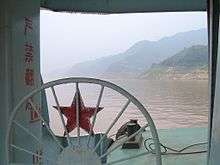
- This article is an itinerary.
This is a huge river; it is over 6,000 km (nearly 4000 miles) long, about the same as the Mississippi. Only the Amazon and Nile are longer. It is the world's sixth largest river by volume of water discharged, at over 30,000 m³ a second, roughly double the Mississippi or Mekong, three times the Saint Lawrence, four times the Danube, and more than ten times little streams like the Rhine or Nile.
Understand
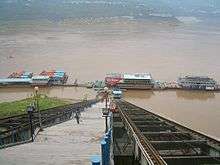
The Yangtze has been an important transportation route with major cities along its banks for several thousand years.
The Chinese Empire first developed along the Yellow River (Huang He) and shortly thereafter spread both to the lower Yangtze basin around Lake Tai (which until then was home to the Liangzhu Culture) and to the rich agricultural lands of Sichuan a thousand km or more up the river. As the main link between those areas, the Yangtze has been important through most of Chinese history.
The Western name "Yangtze" comes from the stretch of the river from Yangzhou to Zhenjiang, called the Yangzi (扬子) in Chinese. This was the name first heard by Western missionaries and traders, particularly by the British, and it has stuck. It is named in honor of the former emperor Yang. Most Chinese will not understand what you mean if you don't use the proper Mandarin title of chang jiang (long river) unless they are familiar with English.
Cities
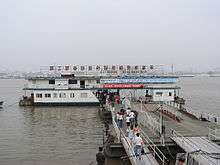
Many of China's greatest cities lie along the Yangtze. Except for Shanghai — which was unimportant until the 19th-century China trade made it one of the world's great cities — all of these have existed for millennia. Listed from the mouth up the river, they are:
- Shanghai, great trading port, financial and fashion capital of modern China
- Wuxi, on Lake Tai, an old city that now has much hi-tech industry
- Yangzhou, center of the salt trade for centuries
- Zhenjiang, the girlhood home of Pearl Buck, a daughter of an American missionary family who grew up to win a Nobel Prize for novels about China.
- Nanjing, national capital under several dynasties, rivals Beijing for historical importance, capital of Jiangsu
- Jiujiang
- Wuhan, important in 19th-century trade and modern industry, capital of Hubei
- Yichang, gateway to the Three Gorges
- Chongqing, one of China's largest cities
- Panzhihua, an iron-mining town with forest, mountain and caving tourism
Several other ancient and important cities are not actually on the Yangtze, but readily accessible from it:
- Hangzhou, capital of Zhejiang — near Shanghai and connected by the Grand Canal to Suzhou and Wuxi
- Suzhou, famous for gardens and canals, abode of scholars, painters and poets — between Shanghai and Wuxi
- Chengdu, capital of Sichuan — near Chongqing and on one of the Yangtze's tributaries
There are dozens of smaller cities as well.
The river extends far beyond Chongqing; its headwaters are deep in the Tibetan mountains. Few tourists doing the Yangtze route follow the river much beyond Chongqing. However, travellers on the Yunnan tourist trail see some of the upper reaches of the river near Lijiang. The Yangtze is also one of the three rivers in Three Parallel Rivers National Park, a UNESCO World Heritage region in Yunnan.
Prepare
Get in
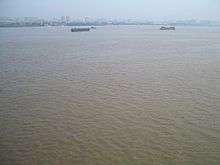
Shanghai has a major international airport with connections to almost anywhere. The other major cities on the route (Nanjing, Wuhan, Chongqing) have airports with good connections throughout China, but few direct international flights. However, KLM flies Amsterdam-Chengdu and Amsterdam-Kunming, Air France flies Paris-Wuhan, Lufthansa Frankfurt-Nanjing and Korean Air has flights from Seoul to several of these cities. Finnair offers direct flights to Chongqing.
From Southeast Asia, a popular cheap flight into the region is Air Asia Kuala Lumpur to Hangzhou.
Go
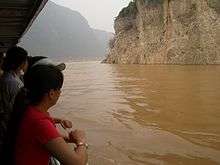
The most famous part of this route is the sensational cruise ships through the Three Gorges area between Chongqing and Yichang. With the recent enormous Three Gorges Dam project, this route has changed considerably but it is still definitely worth doing.
A huge number of people were displaced when the Three Gorges Dam was built; a large area of what used to be fairly densely populated farming country with market towns scattered through it is now underwater. A number of new towns were built in the area and many people were relocated to Chongming District in Shanghai.
Be careful of the different types of boats and classes within those boats. Traveling on a Chinese tourist boat in 'first class' may not be your idea of 'first class' (one traveller complained of "rats everywhere"). In addition, the only choice for food may be the boat itself for up to three days. It is advisable to bring supplies, particularly snacks and drinks, for the voyage. The locals often bring ramen noodles or other soups; hot water is readily available. If you want a good experience on the Yangtze, pay the extra for a luxury cruise. Fare on these often includes excursions with English speaking guides and all meals on-board except the dinner on the check-in day. Almost all the tourists travelling on those cruises are very satisfied with the journey.
While one reviewer suggested not to take the Chinese Tourist boat (since they stop at destinations at 6AM, expecting all passengers to get out and look at the scenery, then arriving at 4AM at the final destination and throwing everybody off the boat), another reviewer had a positive experience despite not speaking any Chinese.
Other tips:
- Rent a private cabin if possible (handy for the many relaxing and lazy periods traveling down river)
- Bring supplies to wash and dry clothes (detergent and clothes line with clothes-line pins) as this will be convenient in your room (although clothes will dry slowly with the humidity.)
- Take photos and video at dusk or dawn when the haze from air pollution is not as pronounced.
- Research the route before traveling so that you have some idea about the sites your boat will stop at and their significance (e.g. Fengdu, the City of Ghosts.)
- Keep a "day bag" packed for those unexpected times when the boat stops for a site (rather than having to look for your camera, and possibly missing the trip with your fellow boat travellers)
The lower Yangtze areas; from Wuhan down through Nanjing and Suzhou to Shanghai; travelling by boat is also an option, but here it is not essential. There are good rail and road connections throughout the area. See High-speed rail in China for Nanjng-Wuxi-Suzhou-Shanghai-Hangzhou routes.
In Hubei, where the river flows across low-lying fertile plains, it is paralleled on both sides with tree-lined levees, on top of which fairly pleasant roads exist. See Hubei#See on more details on traveling along the levees.
Stay safe
General precautions against common scams and pickpockets are advisable anywhere in China.
Be especially wary of thieves on the cruise boats, using any technique from picking pockets to crawling in portholes to rifle luggage.
Go next
Chengdu is a hub for visiting southwest China. From there, you can:
- fly to Lhasa, Tibet — but beware of altitude sickness; Chengdu is under 1000 m and Lhasa over 3500 m
- head Overland to Tibet
- head South toward Kunming, Yunnan by road or rail. If your ultimate goal is Tibet, Kunming at 2000 m is a good place to acclimatize before heading into higher areas.
- swing north by road or rail to Xi'an, or join the Silk Road further west at Lanzhou